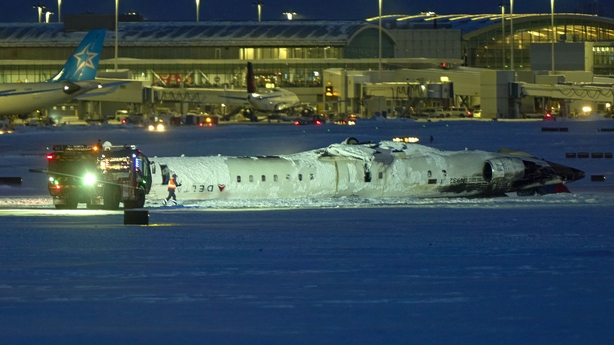Delta Air Lines has said that 19 out of the 21 passengers transported to local hospitals after a plane crash yesterday in Toronto have been released, as officials continue a probe into why the regional jet flipped over upon landing.
Investigators from Canada's Transportation Safety Board (TSB) are leading the probe into why the CRJ900 aircraft operated by Delta Air Lines' Endeavor Air subsidiary went belly-up yesterday at Toronto's Pearson Airport.
It's not yet clear what happened to Flight DL4819 from Minneapolis-St Paul International Airport. Air crashes are usually caused by multiple factors.
The 16-year-old CRJ900, made by Canada's Bombardier and powered by GE Aerospace engines, can seat up to 90 people. At least one of the two wings was no longer attached to the plane, video showed after the accident.
Toronto Pearson Airport said yesterday it was dealing with high winds and frigid temperatures as airlines attempted to catch up with missed flights after a weekend snowstorm dumped more than 8.6 inches of snow at the airport.
The Delta plane touched down in Toronto at 2:13pm local time after an 86-minute flight and came to rest near the intersection of runway 23 and runway 15, FlightRadar24 data showed.
The weather at the time of the crash indicated a "gusting crosswind and blowing snow," the flight tracking website said.
Canadian authorities said they would investigate the cause of the crash, which was not yet known.
Passenger John Nelson posted a video of the aftermath on Facebook, showing a fire engine spraying water on the plane that was lying belly-up on the snow-covered tarmac.
He later told CNN there was no indication of anything unusual before landing.
"We hit the ground, and we were sideways, and then we were upside down," Mr Nelson told the television network.
"I was able to just unbuckle and sort of fall and push myself to the ground. And then some people were kind of hanging and needed some help being helped down, and others were able to get down on their own," he said.

Toronto Pearson Fire Chief Todd Aitken said the runway was dry and there were no crosswind conditions, but several pilots Reuters spoke to who had seen videos of the incident pushed back against this comment.
US aviation safety expert and pilot John Cox said there was an average crosswind of 19 knots from the right as it was landing, but he noted this was an average, and gusts would go up and down.
"It's gusty so they are constantly going to have to be making adjustments in the air speed, adjustments in the vertical profile and adjustments in the lateral profile," he said of the pilots, adding that "it's normal for what professional pilots do."
Investigators would try to figure out why the right wing separated from the plane, Mr Cox said.
Michael J. McCormick, associate professor of air traffic management at Embry-Riddle Aeronautical University, said the upside-down position made the Toronto crash fairly unique.

"But the fact that 80 people survived an event like this is a testament to the engineering and the technology, the regulatory background that would go into creating a system where somebody can actually survive something that not too long ago would have been fatal," he said.
Three previous cases of planes flipping over on landing involved McDonnell Douglas's MD-11 model. In 2009, a Fed Ex freighter turned over on landing at Tokyo's Narita airport killing both pilots. In 1999, a China Airlines flight inverted at Hong Kong, killing three of 315 occupants. In 1997, another FedEx freighter flipped over at Newark with no fatalities.
We need your consent to load this rte-player contentWe use rte-player to manage extra content that can set cookies on your device and collect data about your activity. Please review their details and accept them to load the content.Manage Preferences
Airport delays
Flights have resumed at Toronto Pearson, but airport president Deborah Flint said there would be some operational impact and delays over the next few days while two runways remained closed for the investigation.
She attributed the absence of fatalities in part to the work of first responders at the airport.
"We are very grateful that there is no loss of life and relatively minor injuries," she said at a press conference.
The Transportation Safety Board of Canada (TSB) said it was deploying a team of investigators, and the US National Transportation Safety Board said a team of investigators would assist Canada's TSB.
Global aviation standards require a preliminary investigation report to be published within 30 days of an accident.
Japan's Mitsubishi Heavy Industries, which closed a deal to buy the CRJ aircraft program from Bombardier in 2020, said it was aware of the incident and would fully cooperate with the investigation.
The crash comes after other recent air incidents in North America including a mid-air collision between a US Army helicopter and a passenger jet in Washington that killed 67 people, and a medical transport plane crash in Philadelphia that left seven dead.

